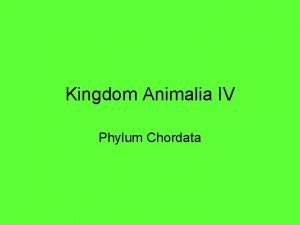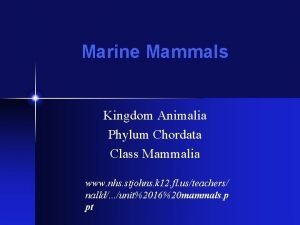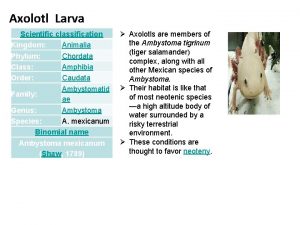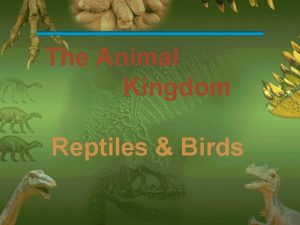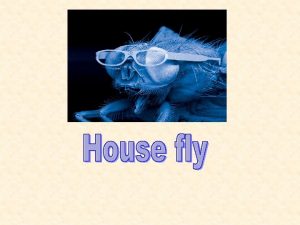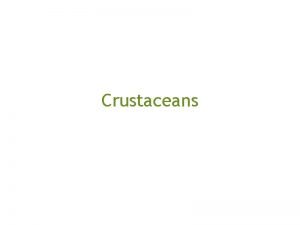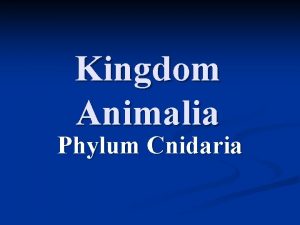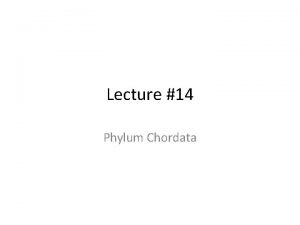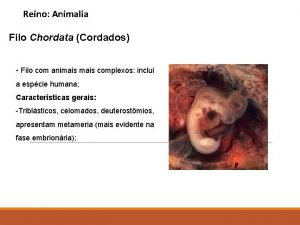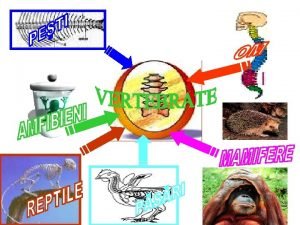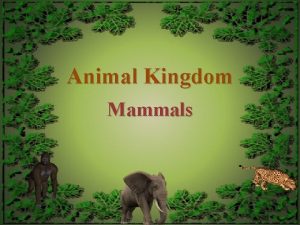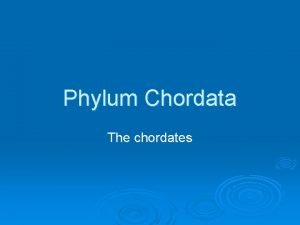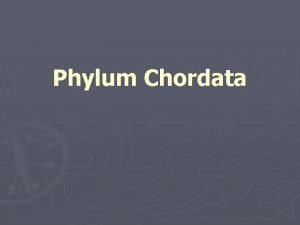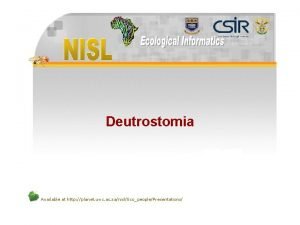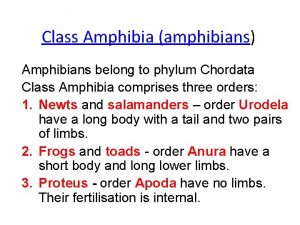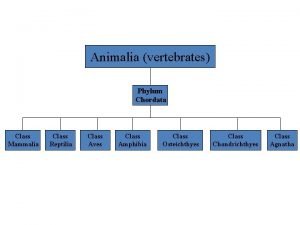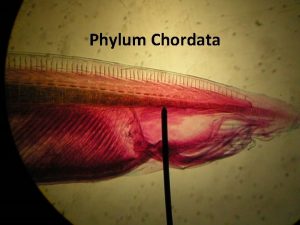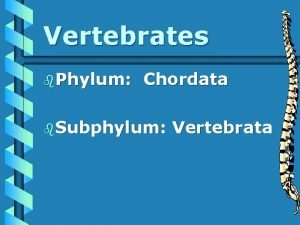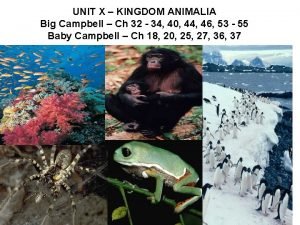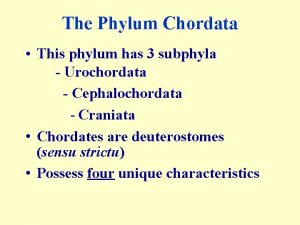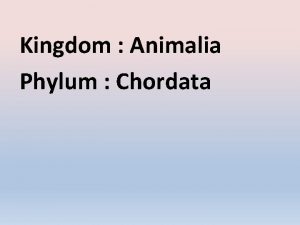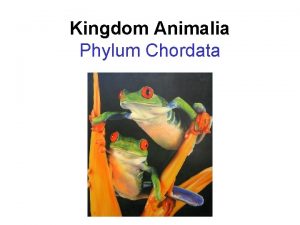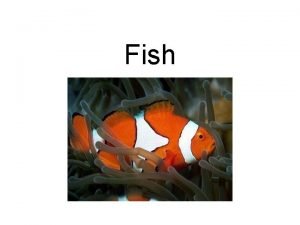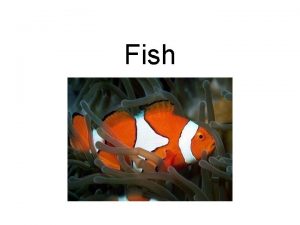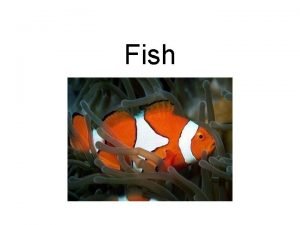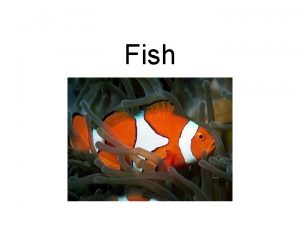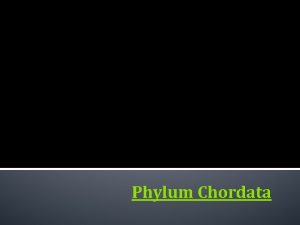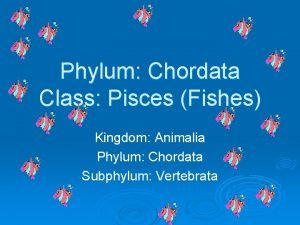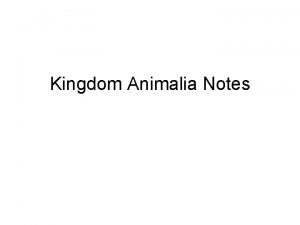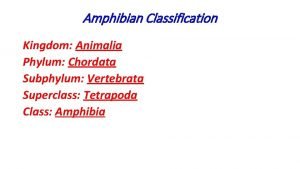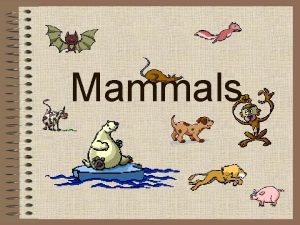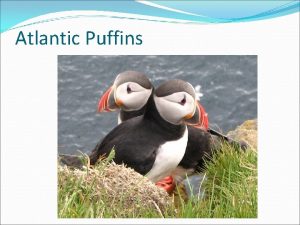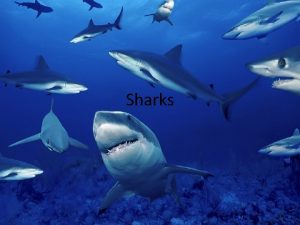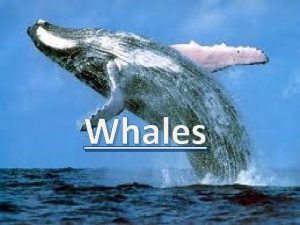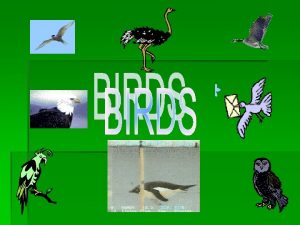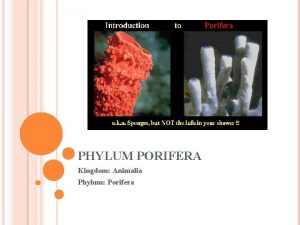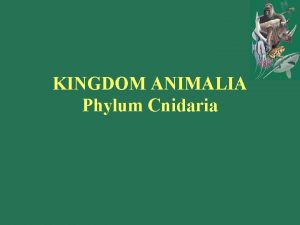Axolotl Larva Scientific classification Kingdom Animalia Phylum Chordata



























- Slides: 27

Axolotl Larva Scientific classification Kingdom: Animalia Phylum: Chordata Class: Amphibia Order: Caudata Ambystomatid Family: ae Genus: Ambystoma Species: A. mexicanum Binomial name Ambystoma mexicanum (Shaw, 1789) Ø Axolotls are members of the Ambystoma tigrinum (tiger salamander) complex, along with all other Mexican species of Ambystoma. Ø Their habitat is like that of most neotenic species —a high altitude body of water surrounded by a risky terrestrial environment. Ø These conditions are thought to favor neoteny.

Ø A sexually mature adult axolotl, at age 18– 24 months, ranges in length from 15– 45 cm (6– 18 in), although a size close to 23 cm (9 in) is most common and greater than 30 cm (12 in) is rare. Ø Axolotls possess features typical of salamander larvae, including external gills and a caudal fin extending from behind the head to the vent. Ø Their heads are wide, and their eyes are lidless. Their limbs are underdeveloped and possess long, thin digits. Ø Males are identified by their swollen cloacae lined with papillae. Ø females are noticeable for their wider bodies full of eggs. Three pairs of external gill stalks (rami) originate behind their heads and are used to move oxygenated water. Ø The external gill rami are lined with filaments (fimbriae) to increase surface area for gas exchange. Ø Four gill slits lined with gill rakers are hidden underneat Ø The axolotl is only native to Lake Xochimilco and Lake Chalco in central Mexico. The water temperature in Xochimilco rarely rises above 20 °C (68 °F), though it may fall to 6 to 7 °C in the winter, and perhaps lower. h the external gills.

Neoteny Ø Axolotls exhibit neoteny, meaning they reach sexual maturity without undergoing metamorphosis. Ø Many species within the axolotl's genus are either entirely neotenic or have neotenic populations. Ø In the axolotl, metamorphic failure is caused by a lack of thyroid stimulating hormone, which is used to induce thyroid to produce thyroxine in transforming salamanders. Ø The genes responsible for neoteny in laboratory animals may have been identified; however Ø They are not linked in wild populations, suggesting artificial selection is the cause of complete neoteny in laboratory and pet axolotls.

PARENTAL CARE -AMPHIBIANS PARENTAL CARE IN THE MEMBERS OF CLASS AMPHIBIA Amphibian include anurans, urodelans and apodans. In all these groups of amphibians we come across with a great deal of parental care. Amphibians show several mechanisms to protect their eggs and developing young ones because of they lay few eggs.

Parents protect the eggs and early developmental stages in two ways. 1) They construct nests 2) Direct Nursing. The female Icthyophis glulinosa will dig a hole in the moist soil near a pond. It will deposit eggs in it. Around this egg mass the mother will coil and. protect the egg mass from the enemies 2. PARENTAL CARE IN E ORGANISMS CF URODELA: In some urodela amphibians the eggs are very small. They hatch end directly develop into larvae. In those organisms parental care is not required.

a) Protection by Nests : - Salamandrella keyserlingi will construct a gelatinous bag like structure. It is attached to an aquatic plant below the water. In this bag eggs are stored. Thus they are protected by the Nest ii) Autodax will lay eggs in a dry hole on the soil or in a hole on a free. The parents also live in the hole and protect the egg and the larvae developed from them b) Direct Nursing by Parents I) Amphiuma, (Congoeel) The mother will coil around the eggs and protect them.

ii) Desmognathus fuscus, (the dusky Salamander) The mother will carry the eggs. They are attached around its neck. L Salamandra salandra, (the European fire salamander) : - The mother will retain few eggs in its body. It liberates the larvae into water. They complete their development in the water. iv) Salamandra atra, (the European alphine salamander) : The mother keeps the eggs in its uterus. It liberates only the young ones which are completed their metamorphosis.

3. PARENTAL CARE IN ANURA AMPHIBIANS: In Mura amphibians the parental care is reached its peak. Many organisms will exhibit parental care. a) Protection by Nests: Many frogs and toads build nests in which the eggs are laid and developed. This is a primitive method of parental care. In these organisms the larva comes out in a very early embryonic stage which requires some kind of protection in the very early stages of development, hence the parent will build nests. I) Hyla Faber: - It is Brazilian free frog. The female will construct the nest in the shallow waters of a pond. The female will dig a hole of 8 to 10 cm depth. The mud which comes out of it is used by the female Hyla to construct a wall around the hole. This wall is raisd’above the level of water. Female Hyla will make the inner surface of this Nursery smooth and even the female will lay eggs in this nursery. The eggs and larval forms are protected inside this structure. ii) Rhacophorus malabaricus It is called chunam frog. It lays eggs on the branches or leaves of a tree which will be hanging over a pond. These larvae after hatching from eggs will fall into the pond water and undergo metamorphosis.

lii Rhacophorus schlegeli It is called Japan free frog. Both male and female frog will make a burrow in the moist soil near a pond edge. This hole is filled with foam by female. Then female lays eggs in this foam. The male and female animals will make an exit tunnel into the pond from the hole. The larvae developed from eggs will be carried by the liquid formed from the foam into the pond through these exit tunnels.

lv) Hyla resinfectris It is a free frog. It will make use of holes in the frees. It will line the hole of free trunk with beewax brought from bee comb. Female animal lays eggs in this hole when filled with rain water. v) Leptodactylus mystacinus It digs a. hale in the moist mud near a pond. This hole is filled with foam which is secrete 4 by the oviducts of the female. Female lays eggs in it. These eggs hatch into larvae then the pond will get good amount of water from rain. Then these holes are also surnounded by the pond water, Then the larvae will enter the pond and grow.

vi) Hyla nebulosa It lays its eggs in a nest. This nest is made by dry leaves. The eggs hatch and develop into small adults. Larval form is absent. vii) Hylodes : It is an American frog. It deposits eggs in moist places or under the stones. The eggs hatch and give tiny adults in perfect condition.

2) Direct Nursing by Parents: This method is more advanced than protecting the eggs and larvae by constructing nests. 1) Alytes. It Is called Mid-wife-toad When the eggs are laid by the female frog winds the strings of eggs round his back and thighs. This male frog lives in a shallow pit of the moist soil, It will came out of the pit now and then for feeding and to make the eggs moist. ready to hatch the male frog moves to a near by pond and the larvae are released

2. Gastrotheca It is called New World brooding (or) Marsupial frog. It has a special pouch in its skin. It opens out through an opening near the cloaca. Fertilized eggs are transferred into this pouch. The eggs are stored in this pouch where they ‘undergo development and tadpoles are liberated out.

3, Pipa americana It is called surinam toad. During breeding season the skin of the back of the female becomes soft and spongy. During copulation the oviducts will come out of the female- Because of the movements of male the eggs are forced out of the oviduct. Each egg sinks into a small pocket of the skin. It gets coveted by an operculum. In the soft maternal tissue the young one can develop safely. The developing embryo has a tail and yolk sac. It has no gills. The tail may work like placental connection to draw nutrition from the mother. Nearly after 80 days small individuals may come out.

4. Rhinoderma darwini It is called little South American frog. The fertilized eggs are transferred into its vocal sacs the development takes place. Then the completely developed young individual will jump out from the mouth of the male frog. Thus in Amphibians a good amount of parental care is seen.







Flow Rate & Energy

Flow Rate & Energy • Results in distribution of matter – CPOM vs FPOM – Gravel, sand, silt • Determinant in ‘floral’ species distribution – Large plants with roots need fine matter – Algae / bacteria like low energy areas • Determinant in animal species distribution – Animals (zooplankton→fish) follow plants

What about the Ecology? • Discuss the trophic structure of a) A river, and, b) A small stream (i. e. Toronto)

The zones of freshwater bodies

Lotic or Lentic? • The diagram represents both systems • It is important that you relate the ecology to the water bodies geography • We shall perform several experiments to help you understand this, including; • Physicals, chemicals, bacteria, PP, algae and macro-invertebrate analysis

Class Group Exercises • Volumetric flow rate determination • Lentic habitat profile • Lotic habitat profile
 What are chordata
What are chordata Kingdom animalia phylum chordata class mammalia
Kingdom animalia phylum chordata class mammalia Seal phylum
Seal phylum Taxonomy of axolotl
Taxonomy of axolotl Animal kingdom phylum chordata
Animal kingdom phylum chordata Diptera phylum
Diptera phylum Kingdom animalia phylum arthropoda
Kingdom animalia phylum arthropoda Polyp vs medusa
Polyp vs medusa Kingdom animalia phylum cnidaria
Kingdom animalia phylum cnidaria Subphylum of chordata
Subphylum of chordata Cordados classificação
Cordados classificação Subincrengatura
Subincrengatura Old kingdom middle kingdom new kingdom
Old kingdom middle kingdom new kingdom Nnn ruled
Nnn ruled Roman empire
Roman empire Old kingdom middle kingdom new kingdom
Old kingdom middle kingdom new kingdom Kingdom family genus
Kingdom family genus Playtpuses
Playtpuses Vertebrates phylum chordata
Vertebrates phylum chordata Notochord characteristics
Notochord characteristics Phylum chordata
Phylum chordata Phylum chordata class amphibia
Phylum chordata class amphibia Avian taxonomy
Avian taxonomy Phylum chordata class reptilia
Phylum chordata class reptilia Chordate animals
Chordate animals Chordata subphylum
Chordata subphylum Cotoderm
Cotoderm Petromyzontidae
Petromyzontidae
